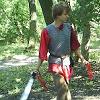Search the Community
Showing results for tags 'smooth curves'.
Found 1 result
-
I was just driving LEGO trains on a LEGO-exhibiton here in Budapest when an idea came to my mind, I really would like to share it with the Train Tech community. I've read Holger Matthes' smooth curves article in Railbricks 1 long time ago, today I played with some straight track segments, building the well-known smooth curve using jumper plate, 1×2 plate and 1×4 plate. Then I looked at a really useful part in the display, this one: Bracket 1*2 - 2*2 And built it's narrower part between the track segments: The studs of the 4 LDU wide part perfectly holds the plate of the track segment (okay, it's illegal connection, but works perfectly), between the 1×2 plate part of the bracket and the other track segment you have to place a single 1×1 or 1×2 plate. The inner side of the curve can be connected with a single 1×2 plate below the track plates, or below and above them, too. Doing some math, calculating the theoretical radius: We have an isosceles triangle, equal sides with 140 LDU distance (LEGO Digital Unit, 1 stud = 20 LDU, 1 brick = 24 LDU, one plate = 8 LDU), the shortest side is 4 LDU long. (Please note, that the bracket brick is inserted by stud 2, not 1 between the tracks, counting studs from outer side of the curve). The half of the isosceles triangle described above is a right triangle, with hypotenuse 140 LDU long and a shorter leg 2 LDU (half of 4 LDUs). The angle opposite of the 2 LDU side is the half of the angle between the tracks, let's name it a. sin a = 2 LDU/140 LDU sin a = 0,0142857 a = 0.8185 degrees 2*a = 1.637 degrees, this is the angle between the two segments. For 90 degress you need 54,97, so 55 connections, which means 56 straight tracks. Lenght of 56 straight tracks is approx. 718 cm (including connections), so the radius is: 716 cm = ( 2*r*PI ) / 4 (it is only a quarter of a full loop) r = 456 cm It could be quite impressive, if you have enough space for a curve like this. If anybody has enough straight and parts to make a try, please do it, my train tracks are reserved for two more weeks. Please discuss!

